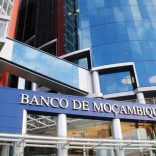Mozambique: Climate Financing Strategy approved - Watch
Bank of Mozambique says banks are solid, capitalized and resilient

File photo: Lusa
The Bank of Mozambique says that the country’s banking sector “remains solid, capitalized and resilient”, and the systemic risk of disruptions in the system is “moderate”.
In the Economic Situation and Inflation Outlook report, dated June 3rd and consulted today by Lusa, the central bank states that, in March 2025, the solvency ratio of the national banking sector stood at 26.5%, above the regulatory minimum of 12.0%, and the liquidity ratio stood at 59.5%, also above the regulatory minimum of 25.0%.
“The macro-prudential solvency stress test, which consists of simulating shocks to assess the resilience of the banking sector, showed that this sector has sufficient capital reserves to absorb potential losses and remain solid and capitalized in the medium term,” the report reads.
The Bank of Mozambique adds that systemic risk, “which assesses the potential contagion effect resulting from disruptions in the banking system, is moderate”. This assessment “reflects the reduction in interest rates and the level of non-performing loans in the market, despite the increase in the banking sector’s exposure to public debt”.
In this sense, the central bank warns that domestic public debt, excluding loan and lease agreements and overdue liabilities, grew to 445.9 billion meticais (€6.103 billion), “which represents an increase of 30.3 billion meticais (€414.7 million) compared to December 2024”.
Central bank data indicate that there are 15 commercial banks and 12 micro-banks operating in Mozambique, in addition to various credit cooperatives and savings and credit organizations.
Lusa reported at the end of May that the refinancing of Mozambican short-term domestic debt issues cost 19.211 billion meticais (€263 million) in the first three months of the year.
According to data from the Ministry of Finance report on the evolution of public debt from January to March, compared to December 2024, this represents an increase of 8.9% in the ‘stock’, corresponding to an additional 36.223 billion meticais (€495.9 million), influenced by the refinancing of short-term debt.
“Although this is a liability management operation, with the aim of mitigating refinancing risks and improving the predictability of debt service, its effects have proven to be adverse due to refinancing under more onerous terms and conditions, contributing to the increase in the debt stock and raising concerns about the effectiveness of the strategy adopted and its sustainability in the medium term,” the report reads.
Domestic debt closed the first quarter at 443,218 million meticais (€6,068 million), the report states.
Mozambique plans to hold five auctions to exchange domestically issued debt this year, totalling almost 26,223 million meticais (€359 million), according to an earlier document from the Ministry of Finance.
According to the document, regarding the situation of Mozambican public debt, the approval of ministerial diploma 87/2024 “marked the introduction of exchange auctions, within the scope of the reform measures recommended by the Medium-Term Debt Management Strategy”, for the period 2022-2025.
This is “one of the liability management operations implemented to improve the public debt profile”, it is justified, adding that five debt swap operations have been identified for this year – the first carried out in March and another scheduled for May (of treasury bonds issued between 2020 and 2022, which mature in 2025) in addition to five similar operations in 2026 and three in 2027.
In March, the financial rating agency Standard & Poor’s downgraded the rating of Mozambique’s domestic public debt issues to Partial Default, due to delays in payments to creditors and changes in a debt issue.












Leave a Reply
Be the First to Comment!
You must be logged in to post a comment.
You must be logged in to post a comment.